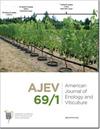无性系和砧木互作对葡萄抗寒性的影响。雷司令和长相思
IF 1.8
3区 农林科学
Q3 BIOTECHNOLOGY & APPLIED MICROBIOLOGY
引用次数: 3
摘要
冷害对全球葡萄种植者构成威胁。葡萄品种的抗寒性各不相同,但无性系和砧木选择对这一特性的影响尚不清楚。在三个休眠季节(2016/17、2017/18和2018/19)对雷司令的五个克隆×砧木组合(克隆49×Riparia Gloire[RG]、49×SO4 Teleki、克隆239×RG、239×SO4和239×Couderc 3309)和长相思的四个克隆(克隆242、297、376和530在SO4 Teleki砧木上)进行了评估。通过差热分析每两到四周对芽的抗寒性进行量化,并将其报告为低温放热。每年都要确定产量和修剪重量。砧木对雷司令芽的抗寒性没有持续的影响,尽管克隆239通常比克隆49更耐寒。在研究的第一年,观察到显著的克隆×砧木相互作用的频率更高。长相思无性系之间没有观察到一致的差异,尽管无性系242和297通常是最不耐寒的无性系。耐寒性的差异与前一个生长季节的产量、修剪重量或作物负荷并不一致。这项研究证明了在可能发生冻害的凉爽气候地区选择克隆和砧木的重要性。在比较不同品种的抗寒性时,未来的研究应考虑克隆身份和克隆×砧木相互作用的可能性。本文章由计算机程序翻译,如有差异,请以英文原文为准。
Clone and Rootstock Interactions Influence the Cold Hardiness of Vitis vinifera cvs. Riesling and Sauvignon blanc
Cold damage is a threat to grapegrowers worldwide. Cold hardiness varies across Vitis vinifera cultivars, but the influence of clone and rootstock selection on this trait is unclear. Five clone × rootstock combinations of Riesling (clone 49 × Riparia Gloire [RG], 49 × SO4 Teleki, clone 239 × RG, 239 × SO4, and 239 × Couderc 3309) and four clones of Sauvignon blanc (clone 242, 297, 376, and 530 on SO4 Teleki rootstock) were evaluated over three dormant seasons (2016/17, 2017/18, and 2018/19). Bud cold hardiness was quantified every two to four weeks by differential thermal analysis and reported as low temperature exotherms. Yield and pruning weights were determined every year. Rootstock did not influence the cold hardiness of Riesling buds consistently, although clone 239 was generally hardier than clone 49. Significant clone × rootstock interactions were observed more frequently in the first year of the study. No consistent differences were observed between Sauvignon blanc clones, although clone 242 and 297 were often among the least-hardy clones. Differences in hardiness were not consistently related to yield, pruning weight, or crop load in the prior growing season. This study demonstrates the importance of both clone and rootstock selection in cool climate regions where freeze injury may occur. Future research should consider the clone identity and the possibility of a clone × rootstock interaction when comparing the cold hardiness of different cultivars.
求助全文
通过发布文献求助,成功后即可免费获取论文全文。
去求助
来源期刊

American Journal of Enology and Viticulture
农林科学-生物工程与应用微生物
CiteScore
3.80
自引率
10.50%
发文量
27
审稿时长
12-24 weeks
期刊介绍:
The American Journal of Enology and Viticulture (AJEV), published quarterly, is an official journal of the American Society for Enology and Viticulture (ASEV) and is the premier journal in the English language dedicated to scientific research on winemaking and grapegrowing. AJEV publishes full-length research papers, literature reviews, research notes, and technical briefs on various aspects of enology and viticulture, including wine chemistry, sensory science, process engineering, wine quality assessments, microbiology, methods development, plant pathogenesis, diseases and pests of grape, rootstock and clonal evaluation, effect of field practices, and grape genetics and breeding. All papers are peer reviewed, and authorship of papers is not limited to members of ASEV. The science editor, along with the viticulture, enology, and associate editors, are drawn from academic and research institutions worldwide and guide the content of the Journal.
 求助内容:
求助内容: 应助结果提醒方式:
应助结果提醒方式:


